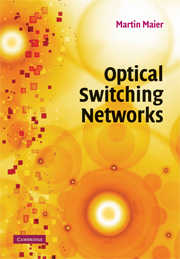Book contents
- Frontmatter
- Contents
- List of illustrations
- List of tables
- Preface
- Acknowledgments
- Part I Introduction
- Part II Optical wide area networks
- Part III Optical metropolitan area networks
- Part IV Optical access and local area networks
- Overview
- 14 EPON
- 15 WDM EPON
- 16 STARGATE
- 17 Gigabit Ethernet
- 18 Radio-over-fiber networks
- Part V Testbeds
- Bibliography
- Index
Overview
from Part IV - Optical access and local area networks
Published online by Cambridge University Press: 10 May 2010
- Frontmatter
- Contents
- List of illustrations
- List of tables
- Preface
- Acknowledgments
- Part I Introduction
- Part II Optical wide area networks
- Part III Optical metropolitan area networks
- Part IV Optical access and local area networks
- Overview
- 14 EPON
- 15 WDM EPON
- 16 STARGATE
- 17 Gigabit Ethernet
- 18 Radio-over-fiber networks
- Part V Testbeds
- Bibliography
- Index
Summary
Future broadband optical access networks not only have to unleash the economic potential and societal benefit by opening up the first/last mile bandwidth bottleneck between bandwidth-hungry end users and high-speed backbone networks but they also must enable the support of a wide range of new and emerging services and applications (e.g., triple play, video on demand, video conferencing, peer-to-peer [P2P] audio/video file sharing, multichannel high-definition television [HDTV], multimedia/multiparty online gaming, telemedicine, telecommuting, and surveillance) to get back on the road to prosperity. Due to their longevity, low attenuation, and huge bandwidth, asynchronous transfer mode (ATM) or Ethernet-based passive optical networks (PONs) are already widely deployed in today's operational access networks (e.g., fiber-to-the-premises [FTTP] and fiber-to-the-home [FTTH] networks) (Abrams et al., 2005). Typically, these PONs are time division multiplexing (TDM) single-channel systems, where the fiber infrastructure carries a single upstream wavelength channel and a single downstream wavelength channel. To support the aforementioned emerging services and applications in a costeffective and future-proof manner and to unleash the full potential of FTTX networks, PONs need to evolve by addressing the following three tasks (Shinohara, 2005):
Cost Reduction: Cost is key in access networks due to the small number of costsharing subscribers compared to that of metro and wide area networks. Devices and components that can be mass produced and widely applied to different types of equipment and situations must be developed. Importantly, installation costs which largely contribute to the overall costs must be reduced. A promising example for cutting installation costs is NTT's envisioned do-it-yourself (DIY) installation which deploys a user-friendly hole-assisted fiber which exhibits negligible loss increase and sufficient reliability, even when it is bent at right angles, clinched, or knotted, and can be produced economically.
[…]
- Type
- Chapter
- Information
- Optical Switching Networks , pp. 221 - 224Publisher: Cambridge University PressPrint publication year: 2008



